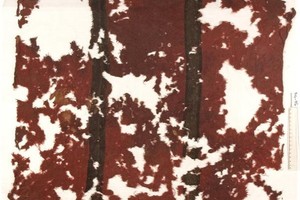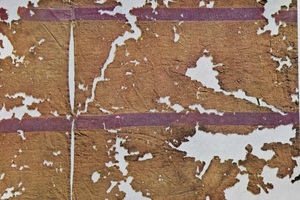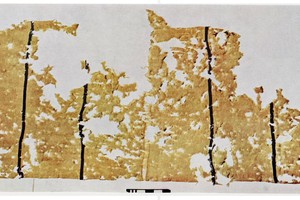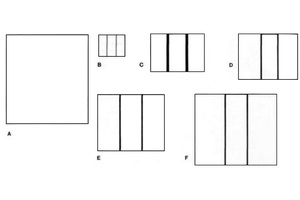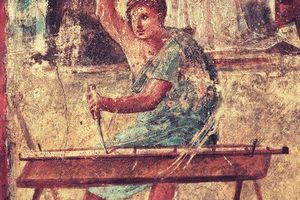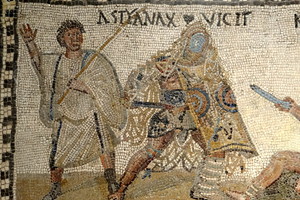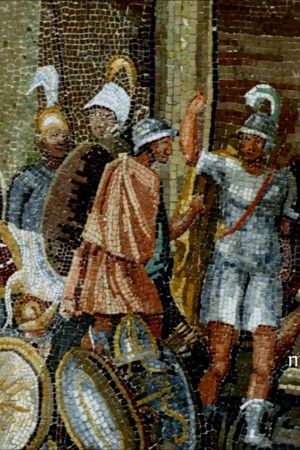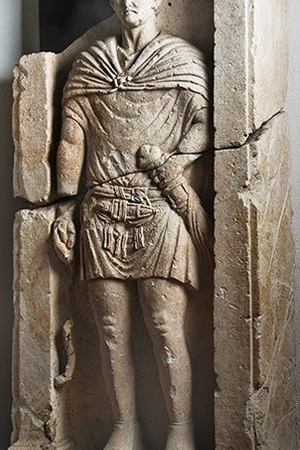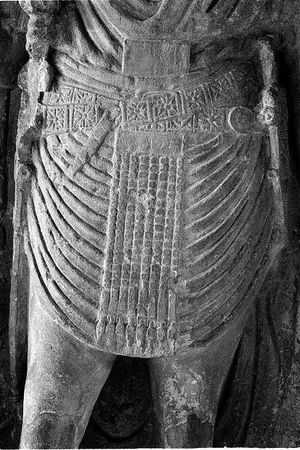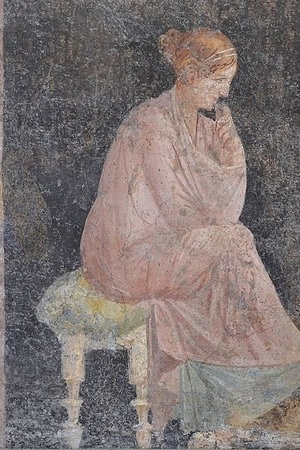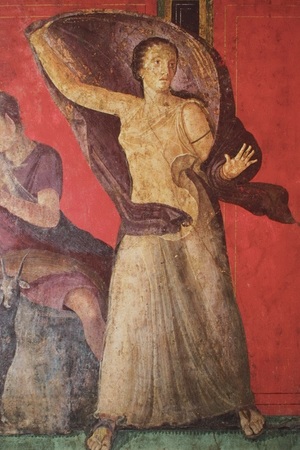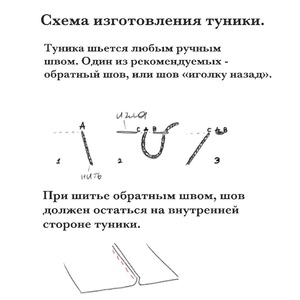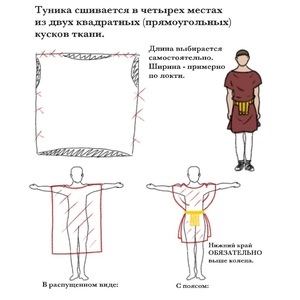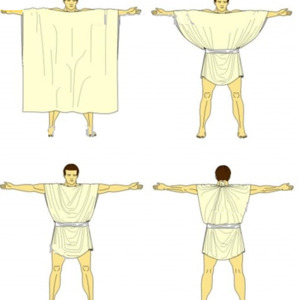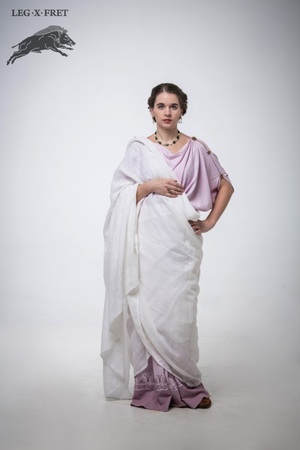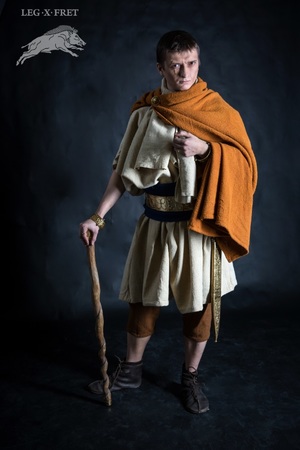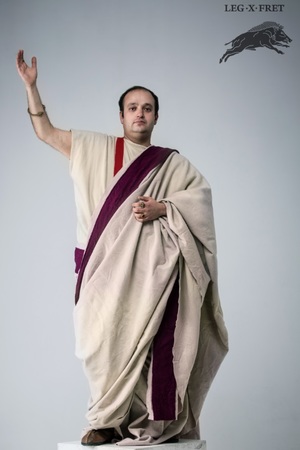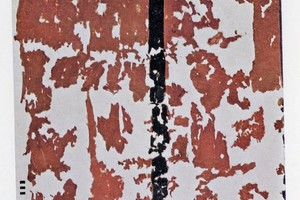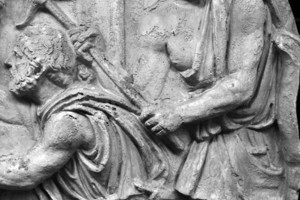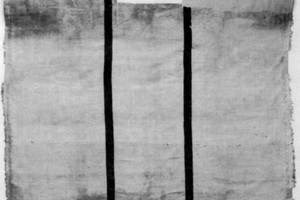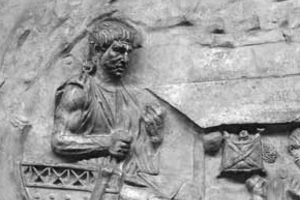Tunic
The tunic (Latin: tunica) was a long, sleeveless garment resembling a rectangle with openings for the arms and head. This type of clothing varied in length and width: women’s tunics reached the ankles, while legionaries’ tunics were above the knees. Wider tunics covered the shoulders, creating a sort of sleeve down to the elbows. The tunic was a simple piece of clothing with no darts or tailoring, and it was adjusted to fit the wearer using belts, ribbons, and clasps. It was also common to wear multiple tunics at once—an under-tunic served as an ancient equivalent to modern underwear, providing warmth in cool weather. This style of clothing was most widespread in Ancient Rome and Greece.
Material
During the Roman period of antiquity, tunics were made from sheep’s wool, with linen being less common due to its higher production cost. Silk tunics were extremely rare—silk fabric was so astronomically expensive that a single tunic could cost as much as an entire villa with slaves. Access to this luxurious fabric, imported from afar, was limited to a select few, and owning a silk tunic was a clear indicator of the owner’s very high status.
Romans typically wove fabric using a simple plain weave, often adorning it with clavi (Latin: clavus or laticlave)—vertical stripes of a different color, woven directly into the fabric. The color palette of clothing greatly depended on a person’s social and financial standing. For example, purple dye was one of the most expensive, and garments dyed in purple were the exclusive privilege of the imperial family. However, in Greece during the time of Alexander the Great, purple fabrics were not considered extravagant and were commonly used in elite military units.
In the Judean and Egyptian provinces, thanks to the climate, many diverse ancient tunics have been preserved, often featuring clavi. Archaeologists have found particularly many such tunics in the Cave of Letters.
Men's Tunic
Men wore tunics that reached the knees. A higher social status allowed one to wear a tunic with clavi—two thin vertical stripes descending from the collarbone. The most common combination was a white base color (the color of undyed wool) with red stripes. In surviving depictions, craftsmen and gladiatorial game judges can be seen wearing such tunics.
Senators could wear a special tunic—tunica laticlavia with broad purple stripes, emphasizing their high social status and wealth.
Below are diagrams of six different tunics:
A) Military tunic described in papyrus BGU 1564. Length: 1.55 m, width: 1.40 m B) Child’s linen tunic. Length: 0.38 m, width: 0.49 m C) Youth tunic from Nahal Hever (No. 6-210). Length: 0.65 m, width: 0.90 m D) Tunic from the Claudian Hill, Egypt. Length: 0.8 m, width: 1.07 m E) Tunic from Nahal Hever (No. 22-8-4). Length: 1.0 m, width: 1.15 m F) Nubia, Egypt, tomb Q150. Length: 1.27 m, width: 1.40 m
Military Tunic
The military tunic differed from the civilian one by its shorter length—belted, it fell just above the knees. Centurions are depicted wearing the shortest tunics. Military tunics were usually plain, with even contrasting stripes being much less common. According to surviving reliefs, legionaries did not wear striped tunics, although it is possible that stripes were simply not depicted to simplify the artwork. Auxiliary troops also wore unstriped tunics, as auxiliaries were not considered Roman citizens until after completing their service.
The primary colors of ancient military clothing were:
Shades of red (orange, burgundy, brick) Shades of blue Shades of green (thought to be used only by auxiliaries) Undyed fabrics (white, cream, gray)
Women's Tunic
Women’s tunics were always long, reaching down to the ankles. The fabric was beautifully draped with numerous folds using ribbons and belts. Women’s clothing was typically in soft shades and pastel tones: pink, orange, green, turquoise, blue.
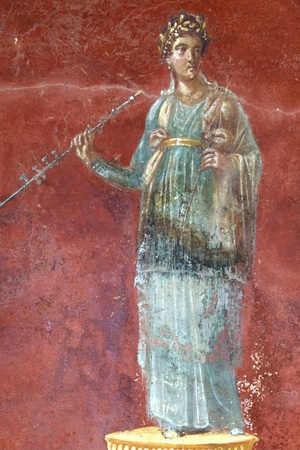 Muse Euterpe or possibly an actress from the time of Nero, Pompeii, Villa Moregine, eastern triclinium, 1st century AD.
Muse Euterpe or possibly an actress from the time of Nero, Pompeii, Villa Moregine, eastern triclinium, 1st century AD.Tunics of Slaves and Gladiators
Slaves wore the cheapest tunics, which could be of any color or undyed. However, there were exceptions, especially if a slave was held in high regard by wealthy masters. Clavi were strictly forbidden for slaves.
There were several types of gladiators who wore short tunics in shades of blue, red, and white. Equites most commonly wore tunics.
Reconstruction
The tunic is a basic wardrobe item for most ancient reenactment outfits. Wool or dense linen with a plain weave is the best material for making a tunic. The color of the tunic should be appropriate for the social status of the character being portrayed in the reenactment. The fabric can be dyed with natural dyes or factory-made in a muted color.
Before sewing, it is recommended to wash the fabric in hot water: it will shrink in length, ensuring that the finished garment will not change shape later. The tunic should be hand-stitched using a backstitch. The edges of the fabric should be pre-finished: folded and sewn to prevent fraying. To create the most accurate reconstruction, you can try to achieve drapery similar to a specific bas-relief, taking into account the extra width needed for creating folds and knots.
Related topics
Legionnaire, Auxiliaries, Matrona, Gladiator Equites, Slaves
Literature
Obnorsky, N.P. Tunic // Brockhaus and Efron Encyclopedic Dictionary: in 86 vols. (82 vols. and 4 extra). — SPb., 1890-1907.

 Gallery
Gallery






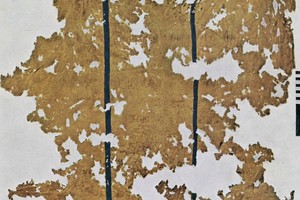 Fragment of a tunic with clavi from the Cave of Letters. Plain weave. First half of the 2nd century AD.
Fragment of a tunic with clavi from the Cave of Letters. Plain weave. First half of the 2nd century AD.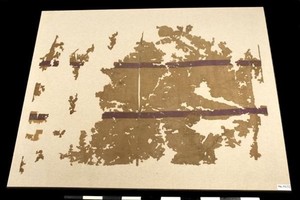 Fragment of a tunic with clavi from the Cave of Letters. Plain weave. First half of the 2nd century AD.
Fragment of a tunic with clavi from the Cave of Letters. Plain weave. First half of the 2nd century AD.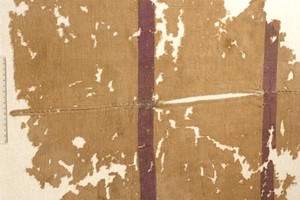 Fragment of a tunic with clavi from the Cave of Letters. Plain weave. First half of the 2nd century AD.
Fragment of a tunic with clavi from the Cave of Letters. Plain weave. First half of the 2nd century AD.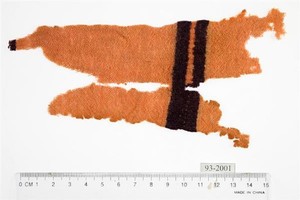 Fragment of a tunic with clavi from the Cave of Letters. Plain weave. First half of the 2nd century AD.
Fragment of a tunic with clavi from the Cave of Letters. Plain weave. First half of the 2nd century AD.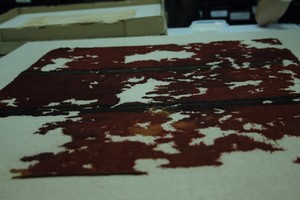 Fragment of a tunic with clavi from the Cave of Letters. Plain weave. First half of the 2nd century AD.
Fragment of a tunic with clavi from the Cave of Letters. Plain weave. First half of the 2nd century AD.